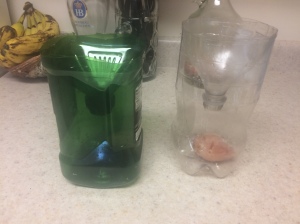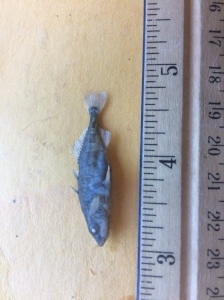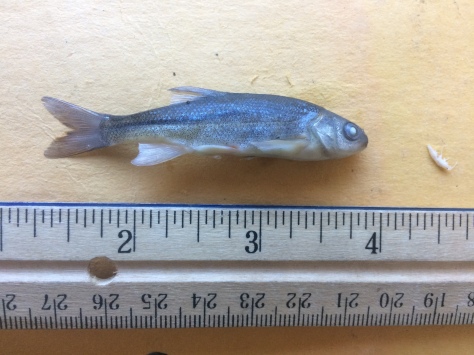By Niall Ogburn and Michael Lutz
This semester we were tasked with the responsibility of testing the water quality in Copeland Creek, as well as getting our hands dirty and finding out what kind or organisms live in the creek (and if they’re native or non-native). To test water quality, we took water samples of the creek to test for pH, dissolved oxygen, nitrate, and temperature levels, all of which are great indicators of the health and well being of the benthic macro invertebrate and fish community that lives in the creek. Often times, monitoring the quality of these factors can tell you a lot about the structure of the aquatic community without physically assessing the species. However, we also assessed the community in the creek to try and get a good picture of the base of the food chain and the organisms that support larger aquatic members of the community such as steelhead and various amphibians.

Satellite photo of the Environmental Technology Center and Copeland Creek. Our study took place in the upper pool marked by the pin.
Our two original objectives were to 1) bring water pH, temperature, dissolved oxygen, and nitrate in compliance with California legislative standards by 2020, and 2) reduce the mosquito fish population by 60% by 2020. These objectives were created before any kind of monitoring took place, and were adjusted as we embarked on our project.
Testing the quality of the water for our first objective involved the use of a few different types of instruments that we had never used before. This was a surprisingly fun experience learning how to use instruments that are actually used out in the field by professionals to measure elements in water quality that reveal important information. We used an instrument called the LabQuest II, a small cell-phone sized piece of technology that has ports for varying attachment probes that measure temperature, nitrate, dissolved oxygen, etc.. The probes are inserted into the water for a period of time until the measurements of the water appear on the screen of the gadget. We used this tool to exclusively measure the dissolved oxygen levels and temperature in the creek. For nitrate and pH, we used an aquarium test kit that involved getting water samples and inserting a test strip into them and comparing the color of the strip to a chart. The use of the aquarium test kit was really an act of desperation more than anything else. As great as the LabQuest II was for measuring water quality, some attachment probes revealed themselves to be defective, so using the test kit was just a way of circumventing the problem.

Underwater photo of the top pool that our study was conducted in. The dark drainage pipe is partly visible in the left background. (Photo credit: Lutz)
Our results were nothing less than astonishing. Taking a look around Copeland Creek, it is very evident how much human activity there is in the dark, and at times disgusting creek. Trash is everywhere, and when I say trash, I mean hypodermic needles, old pieces of clothing, and an insanely large amount of plastic waste. Surely a place with this high amount of human pollution could not possibly hold relatively clean water. And yet, this is exactly what we found: fresh clean water that, on paper, seems good enough to drink (still, I wouldn’t recommend it). This was such a joy to find, especially sense this level of quality was already in line with our objective of bringing quality in compliance with California state legislative standards. The only problem was that according to the state’s clean water act, there is no compliancy standard. Our new objective is to keep these conditions at levels that are adequate for steelhead habitat.
As exciting as these findings were, they were nothing when compared to the findings found from our assessment of the aquatic community. Our initial assumptions were similar to our assumptions about the quality of the water. How many species worth caring about could possibly call these trash infested pools home?
As it turned out, quite a few.
Finding these critters was no easy task. As we walked into the creek on our first day of field work and began looking around, we saw no signs of promise. It took upwards of an hour, using primitive and simplistic methods to get a few Isopoda, a water skeeter, a baby crawfish, and a worm. Not the big haul of species we were expecting. We observed plenty of fish, which our professor suspected were invasive mosquito fish, and we already had plans to use traps to catch a large proportion, with an eye to their removal. We had also heard rumors of a potentially large fish living in the drainage pipe of the highest pool, and even had one blurry picture provided by Caroline Christian confirming its existence. On day one, however, no evidence of the elusive fish was found.
At this point, hopes were not high. It seemed that the only species using these small withering pools were either invasive fish, hardy uncharismatic invertebrates, and a ghost fish. But still we trudged on. On day two of our collection we managed to add two unknown water beetles to our list. We later identified these as walking water beetles, but it was still nothing to get too excited about.
On day three of collection, we decided to implement the traps we had made from 2L plastic bottles, to see if they would be an effective means of catching those invasive mosquito fish. Baited with old dirty chicken, we left the traps to soak in the water overnight for 24 hours. What we pulled up from the depths will forever be in my mind.
Gazing through the plastic bottles, two fish could be seen. One was large (considering the size of the traps entrance) with a big meaty head and a tapering body. It was marbled brown in color and had milky glazed eyes . . . the fish was dead, presumably from lack of oxygen in the trap. Its existence was nonetheless an extremely exciting realization that the creek was home to a variety of fish species. The second fish in the trap was small (about an inch), grey, had three spines sticking out of its back, and was alive. Unfortunately in our ignorance, we assumed this little guy was a mosquito fish that had made its way into the trap, so no thought was given when we preserved the fish in ethanol.
What we later discovered was that the fish was really a California native called a coastal three-spine stickleback. If we had known the fish to be native, we would have released it back into the water to live a happy life, but, as my father always tells me, you live and you learn. The second fish we found was, astonishingly, another California native called a sculpin. These discoveries were very exciting, but more excitement was yet to come.
After the thrills of finding native fish, we decided to get to work catching some of the mosquito fish that were observed swimming in the creek. These were easily caught using an aquarium style dip net. With a little bit of patience, we managed to catch a juvenile and adult fish. They were about 2.5 inches, long and sleek looking, deeply indented caudal fin, greenish silver with a black band on their lateral line, and a closer look revealed that they were not, in fact, mosquito fish (Gambusia affinis).
It took us a great deal of time and investigating to find the identity of our mystery fish. Only through the help of Sarah Phillips of the Marin Resource Conservation Department (RCD), and local fish enthusiast, were we able to I.D. the fish as Hesperoleucus symmetricus, more commonly know as the California roach; a native fish.
This finding felt unreal. Not only to find a third native fish that makes up the majority of the fish community in the pool we assessed, but also that our second objective called for the reduction in their population by 60%. This was a lesson well learned: always check the identity of your problem species before implementing reduction plans.
As we were leaving our from our last day of field work a couple weeks later, one final surprise revealed itself from the darkness. The large mystery fish, suspended in the water column, swam casually out of the large drainage pipe. I tried getting pictures with my phone of the fish from above, but they turned out just as blurry as the pictures shown to us in the beginning of our project. Then I remembered I had a waterproof case on my phone. I stuck my phone in the water and took some pictures. It was through these pictures that we were able to identify the fish as Lepomis cyanellus, a green sunfish. Although “Sunny” is an exotic species that is most likely eating a few California roach, we have decided that Sunny is cool.









